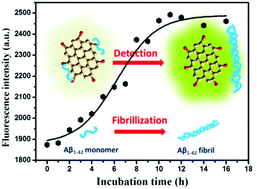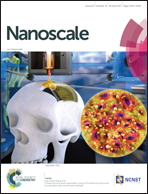Graphene quantum dots for detecting monomeric amyloid peptides†
Abstract
Detection of the concentration of amyloid monomers is of great importance in the diagnosis of amyloidogenesis. Herein, we propose a method to detect the concentration of amyloid β (Aβ) peptide monomers by utilizing the fluorescence characteristics of graphene quantum dots (GQDs). The linear dependence of the photoluminescence (PL) intensity of GQDs on the Aβ monomer concentration can be identified. It can be further illustrated that both monomeric and fibrillar Aβ peptides can be monitored by using GQDs. Conventional fluorescent dyes, such as thioflavin T (ThT), usually undergo co-incubation with amyloid peptides, which could lead to disturbance of the aggregation because of their inhibitory effect. Similar Aβ aggregation dynamics observed by using GQDs and ThT demonstrated the feasibility of the GQD-based detection method without co-incubation with soluble amyloid peptide monomers. The utilization of GQDs as a novel probe monitoring amyloid monomers could be applied in pathological detection and diagnosis of degenerative diseases and other conformational disorders.



 Please wait while we load your content...
Please wait while we load your content...